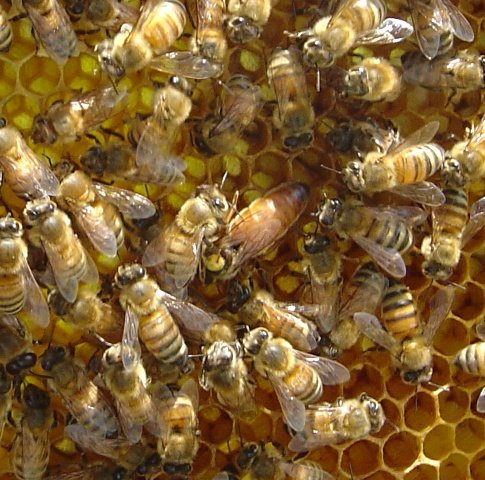The long holiday weekend finds me posting my first blog post for the month of May.
Left: A worker bee collecting pollen and nectar from our peach tree.
For some reason we have experienced a 90% loss of our over wintered hives this season.
Two hive have died in the month of April alone. Not usual once they make it through March
Last week however, the cold wet weather broke, and we are now experiencing warmer days. That means happy days for the bees who are now able to fly and collect the much needed nectar and pollen for the spring buildup.
Today I started rearing a small number of queens.
Right. Newly grafted plastic cell cups. These cells were wet grafted using royal jelly saved from queenrearing in 2010.
It takes 16 days for a queen to grow under the proper conditions. I took newly hatched eggs from three of my hives and wet grafted them into artificial cell cups. Wet grafting is the process of placing a small drop of royal jelly in the bottom of each artificial cell cup, and floating a young larva onto it. (a 50 / 50 mix of plain yogurt and water will do as well for a priming medium)
Eggs from the different hives were grafted into different color cell cups. Red, yellow, and black cups were used. This will allow me to tell which hive the larva was grafted from later on.
The cells were placed into a cell bar and installed in a cell starter hive.
I create my cell starter hives by taking a 5 frame nuc box with a division board feeder half full of sugar syrup, add a frame of nectar and a frame of pollen.
I have modified the nuc box so it has a screened bottom. The entrance is closed so the bees will not be able to leave.
Before I graft the artificial cells, I shake nurse bees (from frames of open brood) into the 5 frame nuc box. I use at least three frames of nurse bees, and two frames of bees from adjoining frames. Of course before I do all this I find the queen, in the contributing hive, and make sure she is not shaken into the cell starter hive!
I took my grafted cell bar frame and installed it in between the pollen and nectar frames.
The trapped nurse bees will have nothing to do but feed the young larva. Because the cell starter is queenless they will build queen cells out of the young larva.
I will wait 24 hours and check to see how many of the grafts were accepted.
Our package bees were delayed from the supplier down south. Many orders were canceled. They must have been having a difficult time there as well.
Last week we finally received our new bees. They had a long trip from Florida, traveling by night, the truck would stop for the day to allow the bees to fly. It took several days to make the trip, and the trailer of bees arrived late one night. About 20 volunteers enjoyed unloading them off the trailer.
We must have been quite the site to the neighbors….. a mass of beekeepers with flashlights (and head lamps) scurrying round a dirt road, walking to and forth, unloading over 200 packages of bees. I know I received at least one strange look from passer buy on the main road. What are you doing walking at the side of the road in a full bee suite? They must have said!
That being said I brought my bees home and installed them the next morning. They were not happy to see me….. I guess they were grumpy from they’re long trip. Several met me with the message I should leave them alone. But…. Then… You have to show them who’s boss! (bees don’t listen well)
Left: A cell starter colony mad up of a division board feeder, a frame of pollen, grafted cells, a frame of open nectar, an undrawn frame, and nurse bees.
The first nucleus of bees was installed without event. Five full frames of bees, honey, and brood were installed on previously drawn out comb. They were very active, fliying the next day in the warm sun.
I noticed that the second nucleus of bees had a recently emerged queen cell, capped brood, but no eggs or larva…. I did see a queen though.
Right: A well feed queen larva. The nurse bees have added royal jelly to the cell. The larva floats on the royal jelly and eats it as it grows. It will take 16 days for the queen to grow from an egg to a fully developed virgin queen.
She must have emerged during the long trip from Florida… But had she mated? Or was she still a virgin, unable to lay worker eggs? I would have to wait to see.
Two days later I checked the hive…. No eggs or brood…. But the queen was still there. Perhaps I would have to replace her with a laying queen…. If one could be found this time of year…..
Two days after that I checked the hive again…. Yes, there were new eggs laid in many cells. I guess this queen might just be fine. Perhaps she had mated during the trip north, while the truck was stopped in another state, and had managed to find her way back to the truck before it continued on.
Perhaps she has a little Pennsylvania or Georgia influence in her now! If you know what I mean!
Maybe she will be just fine…..
Maybee


















































